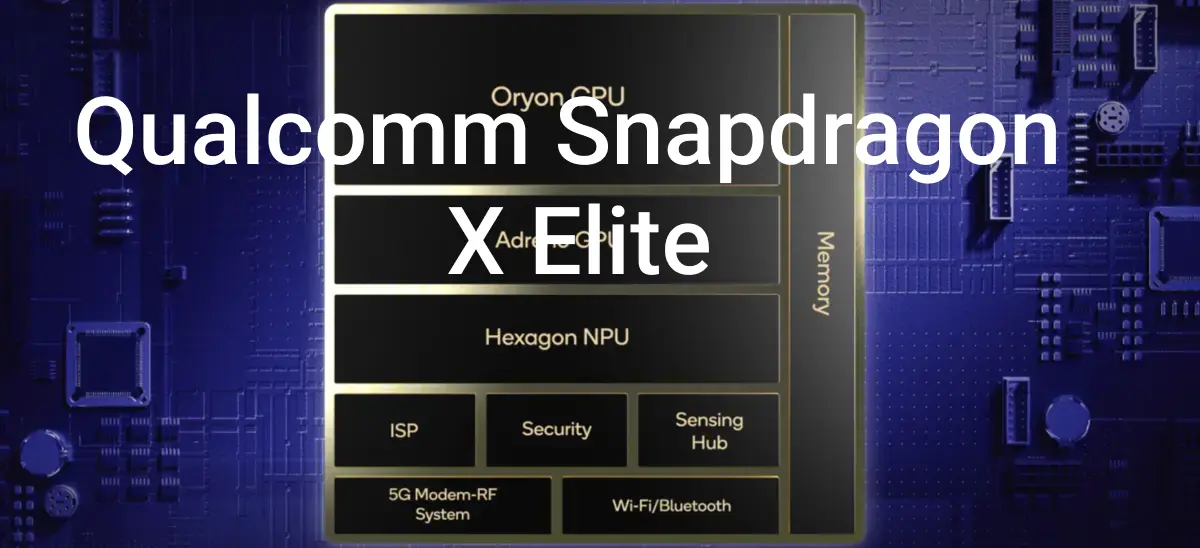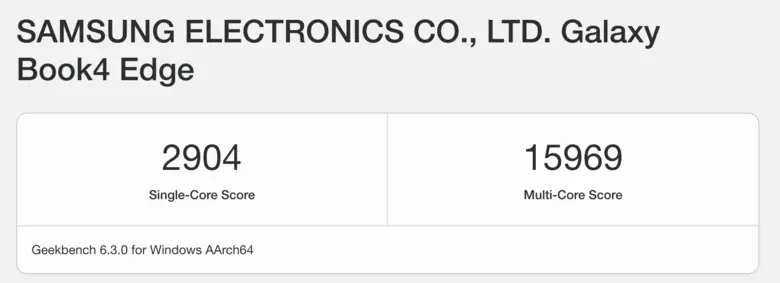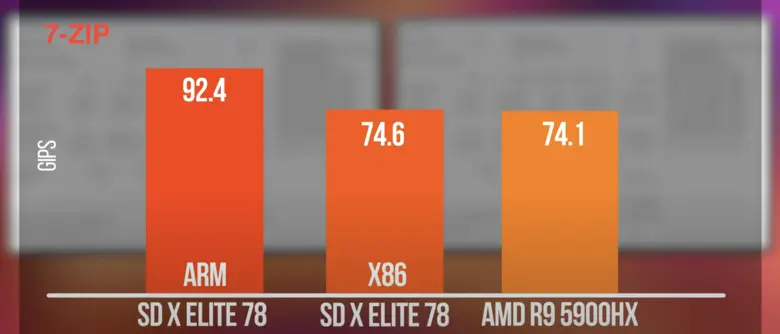
Qualcomm has introduced a new line of Snapdragon X Elite processors aimed at the high-performance laptop market. These chips are designed to compete with solutions from Apple, Intel and AMD, offering impressive performance and energy efficiency.
Qualcomm introduced three processor models in the Snapdragon X Elite line, each of which has its own features. Snapdragon X Elite is built on a 4nm process and uses Oryon cores developed by Nuvia (acquired by Qualcomm in 2021)
1. X1E-84-100 - flagship model:
- 12 cores
- 42 MB cache
- Base frequency: 3.8 GHz
- Turbo Boost: up to 4.2 GHz
- Graphics core: 4.6 Tflops
2. X1E-80-100 - medium model:
- 12 cores
- 42 MB cache
- Base frequency: 3.4 GHz
- Turbo Boost: up to 4.0 GHz
- Graphics core: 3.8 Tflops
3. X1E-78-100 - basic model:
- 12 cores
- 42 MB cache
- Base frequency: 3.4 GHz
- Without Turbo Boost
- Graphics core: 3.8 Tflops
All three models have the same number of cores and cache size, and also support LPDDR5x memory with a frequency of 8448 MT/s. In addition, all of them are equipped with a neural processing unit (NPU) with a performance of 45 TOPS.
Comparison of models:
The main differences between the models are clock speeds and graphics core performance:
- The X1E-84-100 offers the highest performance with a maximum frequency of 4.2 GHz and the most powerful graphics core (4.6 teraflops).
- The X1E-80-100 occupies the middle position with a maximum frequency of 4.0 GHz and a graphics core of 3.8 teraflops.
- The X1E-78-100 is the base model without Turbo Boost, but retains the same 12 cores and 3.8 teraflops graphics core
Performance:
The new Snapdragon X Elite processors deliver impressive performance, especially in multitasking modes. In Geekbench 6 tests, the flagship Snapdragon X Elite performed comparable to, and in some cases even surpassed, high-end processors from Intel and AMD.
In Geekbench 6 tests, the Snapdragon X Elite even outperformed the Apple M2 processor.
Galaxy Book4 Edge X1E-84-100 Geekbench 6 results

MacBook Pro 16 m2 max Geekbench 6 results

Snapdragon X Elite shows impressive results in tasks related to artificial intelligence. According to Qualcomm, the Snapdragon X Elite is 2.6 times faster than Apple M3 processors when it comes to AI. This is a significant benefit that may be especially important in light of the growing role of AI in various applications and services.
This superiority is due to the powerful Qualcomm Hexagon Neural Processing Unit (NPU) integrated into the Snapdragon X Elite. The NPU delivers performance up to 45 TOPS (trillion operations per second), enabling machine learning and artificial intelligence workloads to run efficiently on-device.
This benefit can be especially important for users working with AI applications for image processing, speech recognition, data analytics and other tasks that require high AI performance.
Unfortunately, not everything is so good :(
Despite the high performance, the new Snapdragon X Elite chips require efficient cooling to maintain stable performance. Under prolonged loads, processors can drop frequencies by 200-400 MHz, depending on the heating level.
This phenomenon, known as throttling, is common in many modern high-performance processors. In the case of the Snapdragon X Elite, the reduction in frequencies can be observed especially in compact laptops with limited cooling capabilities.
It is important to note that the degree of frequency reduction depends on the specific laptop model and the efficiency of its cooling system. Laptop manufacturers must pay special attention to the thermal design of their devices to maximize the potential of Qualcomm's new chips.
Users should be aware that the stated maximum frequencies of Snapdragon X Elite processors can only be achieved under short-term loads or in conditions of effective cooling. During prolonged operation under load, actual frequencies may be 200-400 MHz lower than declared, which may affect the overall system performance.
It’s also worth noting that gaming performance still remains the weak point of Qualcomm’s new ARM chips.Some games may not launch or may be unstable, indicating that the software may need to be further optimized for this architecture.
It is important to note that the performance of Snapdragon X Elite processors may be significantly reduced when running programs that are not optimized for the ARM64 architecture. On average, the performance drop for such applications can be 15-20%, and in some cases even more.
7-ZIP ARM X1E-78-100 vs 7-ZIP x86 X1E-78-100 vs 7-ZIP x86 AMD R9 5900HX

This is because Snapdragon X Elite processors use the ARM architecture, while most existing Windows software is designed for the x86/x64 architecture used in Intel and AMD processors. To run such programs on ARM processors, emulation is used, which inevitably leads to reduced performance.
Key points to consider:
- Native Applications optimized for ARM64 will run at full performance.
- Popular Microsoft programs and applications (including Office) are already optimized for ARM and will work efficiently.
- Many professional applications, games and specialized software may run slower due to lack of optimization.
- The performance of emulated applications may vary, some may run almost without loss of speed, others may be significantly slower.
- As time goes on, it is expected that more developers will optimize their applications for ARM, which will gradually solve this problem.
Users considering purchasing Snapdragon X Elite-based devices are advised to check the compatibility and performance of the software they need beforehand. For many everyday tasks, such as running office applications, surfing the web, and streaming media, the performance hit may not be noticeable, but for specialized tasks it can be a significant factor.
Conclusion:
Overall, the new Snapdragon X Elite chips are a real breakthrough for Windows devices, comparable to the advent of Apple Silicon for Mac computers. They deliver impressive performance in most tasks, especially multi-threaded applications and web browsing, making them serious contenders in the high-end laptop processor market.
However, like any new technology, the Snapdragon X Elite is not without its drawbacks. Among the main disadvantages are compatibility problems with some applications and games that are not optimized for ARM architecture, as well as potential problems with overheating and lower frequencies under prolonged loads.Despite these limitations, Snapdragon X Elite represents a significant step forward in the evolution of ARM processors for Windows devices and has the potential for further improvements as software optimizations and the ecosystem evolve.